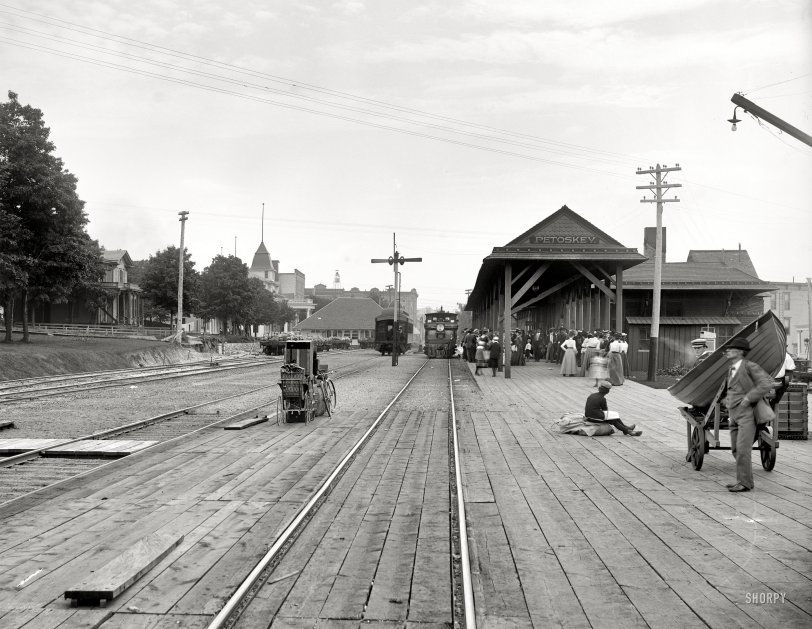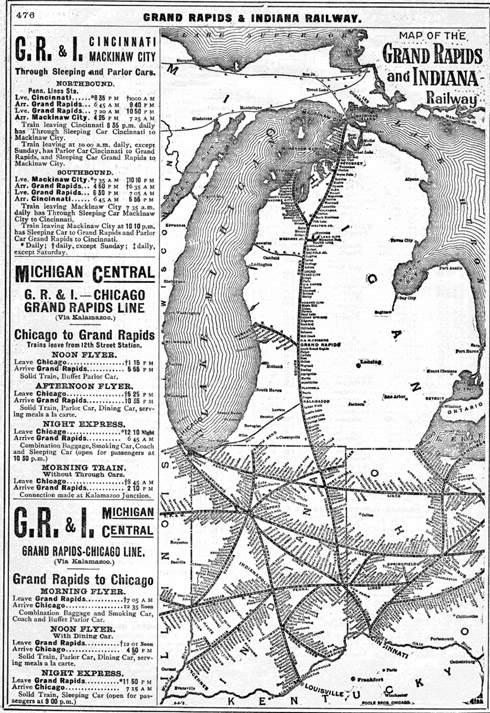


Framed or unframed, desk size to sofa size, printed by us in Arizona and Alabama since 2007. Explore now.
Shorpy is funded by you. Patreon contributors get an ad-free experience.
Learn more.

- Alas, hidden from view
- Exclusive pump
- Details, Details
- What's that building to the left of the tower?
- Coal Barges
- Bromo-Seltzer
- Inner harbor
- The Basin
- What a headache!
- Giant stepladder?
- Baldwin 62303
- Baldwin VO-1000
- Cold
- No expense spared
- Tough Guys
- Lost in Toyland
- And without gloves
- If I were a blindfolded time traveler
- Smoke Consumer Also Cooks
- Oh that stove!
- Possibly still there?
- What?!?
- $100 Reward
- Freeze Frame
- Texas Flyer wanted
- Just a Year Too Soon
- WWII -- Replacing men with women at the railroad crossing.
- Yes, Icing
- You kids drive me nuts!
- NOT An Easy Job
Print Emporium
Meanwhile, Back in Petoskey: 1900

Petoskey, Michigan, circa 1901. "Grand Rapids & Indiana R.R. station." 8x10 inch dry plate glass negative, Detroit Publishing Company. View full size.
"cowcatcher"?? Puleeze!!
The proper term used by railroad personnel is "pilot".
The "station semaphore" is properly called "order boards" and the "water spout" was commonly called a "standpipe".
Possibly, in other parts of the world, these other terms may have been different, but "cowcather": never!
Suburban Station at Petoskey
This is the GR&I (later PRR) suburban station at Petoskey, which operated during the summer months for tourists headed out for the day at Walloon lake or Alanson. The steam engine pictured could operate in either direction (without turning on a wye track) to facilitate quick turnarounds. This suburban station was located about two blocks to the south from the main passenger station which still exists in 2011, without passenger train service.
Railroad expansion plans
Compare this one to the Petoskey depot view posted a few days earlier. Station platform is longer and has a new roof structure in 1908. New station platform surface. More tracks about the depot -- the expansion process is evident in this picture with rock wall stone on the flat cars. Extra track is to be added and the water spout seems to be missing in '08 shot -- as is the station semaphore signal. Engine number 4 is backing toward you in this view -- and may be the engine in the foreground in the 1908 view -- a number 4 seems to be on the forward headlight number board of the 4-4-0 in the '08 view though it is not clear. The engine cabs are a bit different -- back cab windows are at a higher level in the 'o8 photo. Rolling tail light shade is missing in this shot but evident in the '08 view.
Tank Engine
The loco is a tank engine -- it has no separate tender. Both the coal bunker and water tank are carried on a rearward extension of the loco frame, in this case on a four-wheeled truck. It is a type of engine commonly but not always correctly referred to in the US as a "Forney." They were designed to be run safely at track speed in either direction without turning, making them well suited to suburban trains.
Next Stop
You are right, the engine is designed to run tender first at the head of the train. The likely destination is Harbor Springs, which was served by a branch line diverging just north of Petoskey. Another depot photo shows a main line train on the track adjacent to the station, and a branch line train with a similar engine, tender first, on the next track. In some eras, through Pullmans were carried from Cincinnati and Chicago, dropping wealthy tourists close to their lake front hotels.
It's a double ender
In this era about the only locomotives with big headlights on both ends were either switchers or double-enders. The catcher on the rear does indeed indicate this hog has regular assignment on a job where half of the trips are backward.
The earlier picture of Petoskey shows a train ready to leave here, probably with this very engine, running in reverse.
If you search an old GR&I timetable from this time, you'll find out where this train was going. It probably ran to some branch terminal that had no turn facilities, or it may have ended its run at some main line station that had no turn facility.
One of the most famous short line steam roads today, Pennsylvania's Strasburg Rail Road has been doing that from the start; there never have been turn facilities at Strasburg.
Take a ride on the GR&I
Typical Trolley Stop
Ok typical turn of the century trolley stop. two trolleys numerous interesting people, wait a second go back the sort of dapper guy in the foreground with the lapstrake skiff on a hand truck. Excuse me buddy but you can't take your fishing boat on the trolley even if you pay 2 fares.
I am really trying to figure this one out and just what is he doing with the boat at a trolley stop, we will probably never know.
[He's taking it (or sending it) somewhere else. This is, as noted in the caption, a railroad station, not a a trolley stop. - Dave]
Sorry Dave I was only looking at the Trolley that was probably bringing people to the train. But on another note, why is there a man sitting in the boat? is he part of the shipment?
Engine/Tender
I'd like to see that engine and tender from the side; it appears that it's a commuter run (from the crowd on the platform) but it must run in reverse a lot because of the cow-catcher on the tender. No turn wye at either end of its run? Railfans - help?
Always a first here
Never have seen a boat on a baggage carrier before.

























On Shorpy:
Today’s Top 5